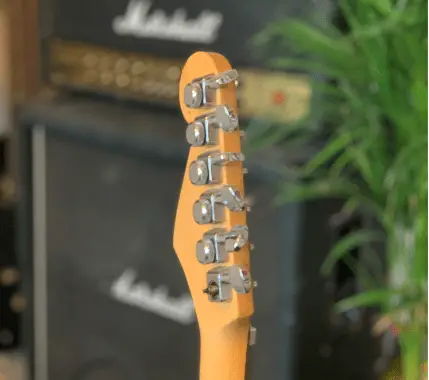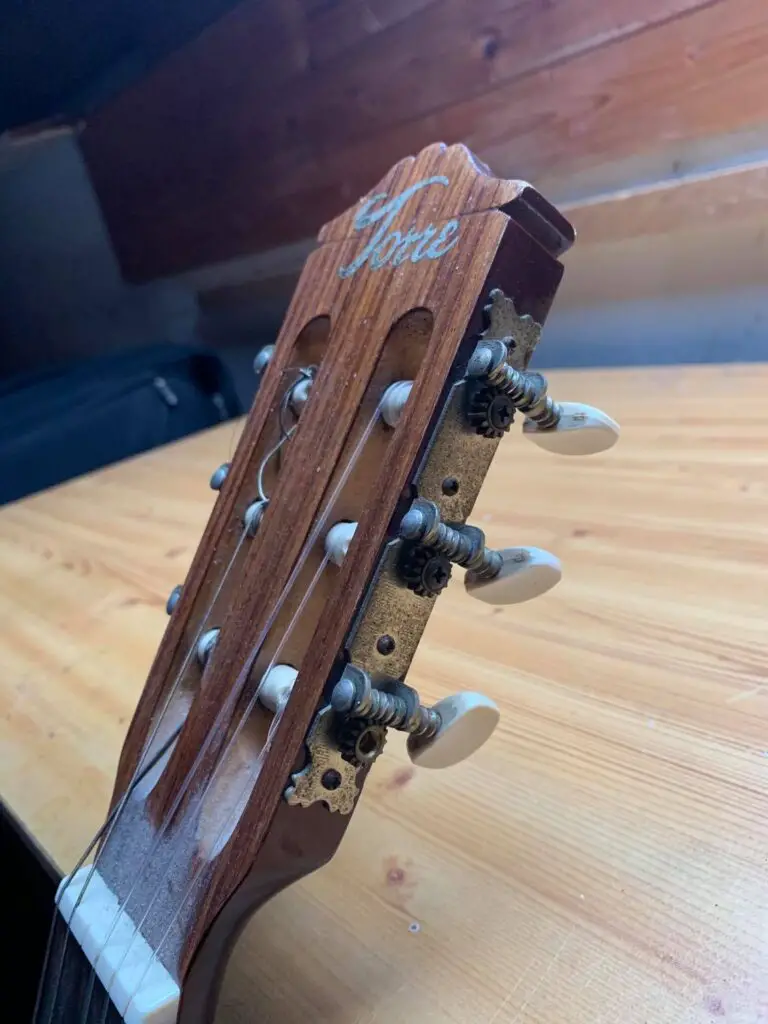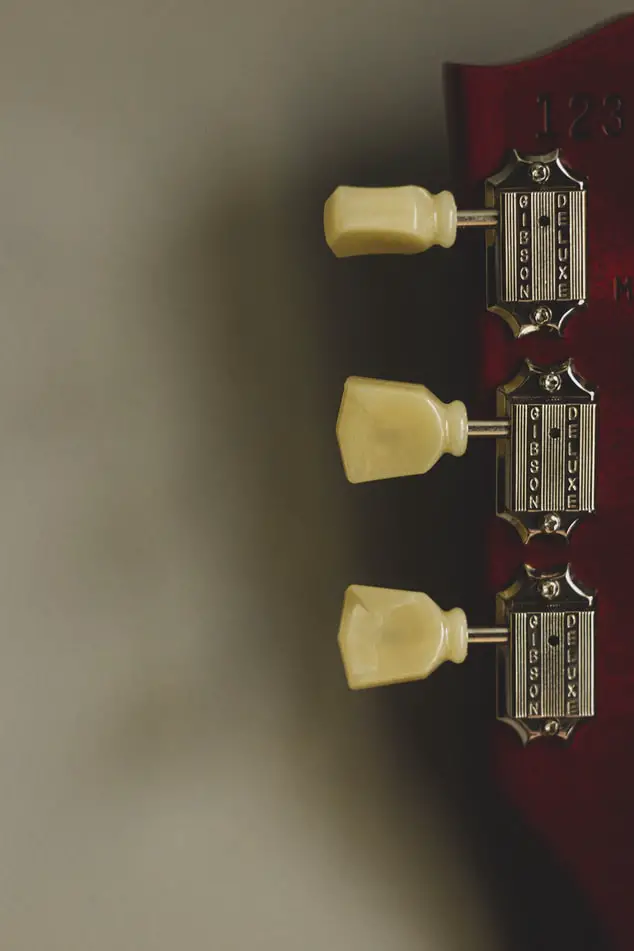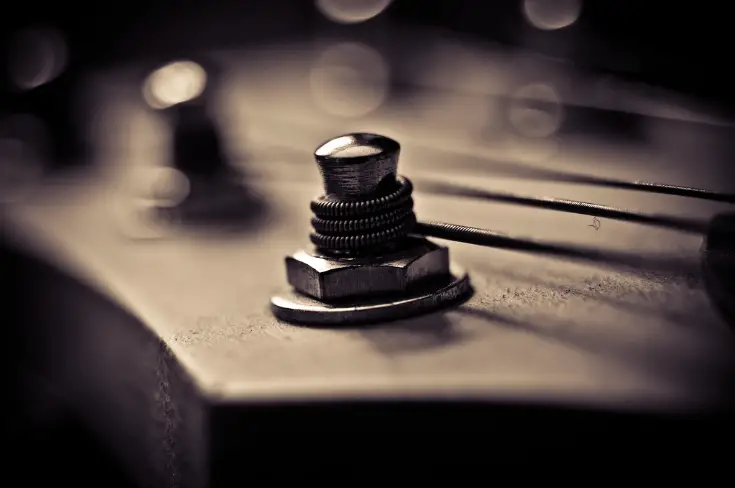Did you know there are SIX main types of tuning machine heads? These are important to understand as they can vary in tuning accuracy and design!
Machine Head Types? There are SIX main types of tuning machine heads which include Sealed tuners, Lock-in tuners, side mounted tuners, vintage closed-back, vintage open-back, and staggered posts.
There are many types of tuners but they generally fall into the category of Vintage or Sealed Machines.
Let’s get started! We will look at these in more detail below…
1. Sealed Tuning Machines
The sealed tuning machine heads are the most common tuners that you will find. These are mainly made from steel making them very robust. However, functionality can vary depending on what brand you purchase.
1.1 The BEST Types of Sealed Tuning Machines
Gotoh Schaller-style Knob Chrome Tuners (6-in-a-line) with mounted screw
6 in-line are made for Fender design headstock where the tuners are is rows of 6
Gotoh Large Schaller-Style Knob Tuning Machines, 3 Left & 3 Right, Chrome with mounted screw
3 left & 3 right for Gibson designed headstock where the tuners are in rows of 3
If you are looking to replace, or upgrade your machine heads then I would personally recommend Gotoh as the gear system is really smooth and precise for accurate tuning capability, as well as holding the tuning extremely well!
1.2 How to Identify the Correct Replacement
As you can see from the product image above the sealed tuning pegs have a housing casing that contains the gears. Thus, not exposing the gears to the outside. These usually have a 10mm threaded bushing with surrounded washer and held to the headstock by a single screw piece. Sealed tuner peg holes can vary from 3/8-inch to 10mm depending on the brand.
Sealed Machine Type?
Firstly, it is important to identify the type of sealed machine that your guitar uses. There are two types of sealed tuners.
Sealed tuners are either 6 in-line or 3 left & 3 right (check product details in the table above). Each of these can also have two types of variations. This basically means that machine heads are positioned in a row of 6, or row of 3.
Mounted Screw Vs. Index Pin
Your guitar can also be mounted to your headstock in two different ways.
- Sealed tuning nut with Mounted screw – the most common of the sealed tuners are mounted with a screw. These fix the machine head onto the headstock.
- Sealed tuning nut with indexing pin – very rarely you will find the machine head is not fixed and is held by a indexing pin. You will notice underneath the housing that there is a pin. The machine head will fall out once you take the strings off as the tension of string then holds the machine in place.
1.3 Advantages & Disadvantages of Gotoh Sealed Tuners
Pros
- Gotoh tuning nuts have a diecast housing that encloses the worm and cog gear (basically a metal alloy that surrounds the gears) to keep out dirt and debris out. They also have the added benefit of keeping them permanently lubricated.
- IIRC state that the sealed machines are lubricated for life. This means they do not wear out as fast because abrasive contamination can never get into the working parts of the machine. This is because abrasive contamination accelerates the wear of the teeth of the gears that over time makes it harder for the machine head to hold the tuning.
Cons
- The disadvantages of the sealed machine heads is in the aesthetics. They do not look as appealing as say a vintage open-back.
2. Lock-In Tuning Machine Heads
These are an absolute god send and i could not recommend them enough!
Locking-screw machine nuts have the locking screw built onto the sealed unit. These come as kind of an add that are only built on the sealed machine.
Important note: these are not compatible with headstocks that offer a floyde rose but will work on a Fender type whammy.
If you are looking to upgrade your guitar then I highly recommend lock-in tuner. This is because the pressure applied by locking screw prevents string slippage. I hardly need to tune my guitar anymore, and i use the Gotoh Magnum tuners.
2.1 Example of lock-in screw (without Floyd Rose)

The particular Fender Stratocaster of mine (demonstrated in the above image) has locking screws built into the tuning machine.
As you can see I have taken the bottom locking-screw just so that you can see clearly how easy the locking screw latches onto the side of the tuning machine nut. Thus, adding pressure on the thread of the string keeping it in place.
I think this is a perfect example of how Fender has prioritized stability but still making the tuning option very flexible.
2.2 Lock-in Screw Machine Head VS. Floyde Rose Lock-in Nut
Instead of locking the strings where they would normally wrap around the tuning machine nut, the Floyd Rose lock the strings at the base of the headstock (where to headstock meets the fretboard).
This guitar is fine-tuned at the tremolo.
If your guitar has a Floyd Rose tremolo then it will definitely have locking screw on the nut and at the bridge. Making the tuning process slightly more complicated for a Floyd Rose.
3. Vintage Open-Back Machine Heads
The vintage open-back tuners are the first type of machine head that has come into existence. Back in the day you would see that they were originally made from wood. But, as technology advances so does the materials that we use to make them.
Today, vintage tuners have the ability to perform just as well as the sealed machines, they only really differ in price (Yes, they are generally more expensive) and aesthetics. For example, if you are restoring a vintage guitar then i would definitely recommend investing in the vintage style tuners. Anything that is a close representation of the original will increase the overall value of the guitar.
3.1 Comparison of Vintage Open-Back Machine Head
When discussing the above you get what you pay for. For example, Waverly is the BEST of ALL brands as they promise life time guarantee and the tuning is so smooth and most accurate. In addition, the Groovers are a really close second, these are what I go for personally as the performance is close to Waverly. I would only recommend the unbranded vintage tuners if you are repairing a cheap budget guitar.
3.2 How to Identify Vintage Open-back Tuners
The best way to identify the traditional vintage tuning machine heads is from the exposure of the gear cogs and the groove bushing on the front of the guitar headstock. If you are not familiar with the component on the headstock then please read the article I wrote entitled “all the components of a machine head” where I explain them all in detail.
Because of the vintage open-backs, have the exposed gear cogs they are often referred to open-back tuners. Overall, the vintage tuners all consist of press fit bushing, which will fit into ¼-inch holes on the headstock.
3.3 Pros & Cons of the Vintage Open-Back Machine Heads
Pros
- The vintage open-back machine heads have a popular opinion of being the most attractive tuners because of the vintage aesthetics.
- This will most likely be anyone’s first choice for someone who loves to play the older classic guitars. This is because the vintage open-backs were the type of machine head that came standard back in the 60’s, 70’s and 80’s.
- As time passes these guitars are now in the hall of fame as collectable items and the vintage open back aesthetics is just part of their charm. Mainly, because of popular opinion people think that open-backs are better suited to the designs of vintage guitars.
- They also generally weigh somewhat less as they do not have the protective housing that the sealed machines have. Overall, this has bearing on balance and total mass of the neck/headstock.
Cons
- The problem with the Vintage Open-Back Machine head is that they do not last as long as the sealed gear types.
- This is because the gear and internal mechanisms are exposed to the outside where dirt and debris can take its toll. After a few years, you will start to see and feel the worn.
- This is an even bigger problem if you own as classical Stratocaster from the 70’s. These guitars can be worth tens of thousands of pounds (£$), and by changing out parts is significant to the value of the guitar.
- Luckily, there are quality high-end brands that can replace the old tuners and still keep the value of the collectable if installed correctly (such as the Waverly’s). In addition, vintage style tuning machine head also have a detailed design and for this reason, they usually cost more to replace.
4. Side-Mounted Machine Heads
The side mounted machine heads are a very similar design to the Vintage open-back but have two major differences. This includes 3 tuners being mounted on the side of the headstock. As well as always 3 in-line (meaning that 3 of the tuners are attached onto a single plate).
In addition, they have similarities to the vintage open-backs as just like the vintage open-backs they have no housing and the gears are exposed.

The side-mounted machine heads are only found on classical acoustic / flamenco guitars that use nylon strings and attach to the tuning post in a slightly different way.
4.1 Comparison – Side-Mounted Machine Heads
| Image | Product | Details | Price |
|---|---|---|---|
| Gotoh (recommended) Side-mounted Machine Heads | High Quality |
Check Price |
|
| Tenor Dragon and Phoenix (Premium) Classical Guitar Tuners | Check Price |
||
| Golden Gate Side-mounted Machine Heads | Check Price |
||
| Ammoon Alice AOS-022V1P 2pcs(L&R) Acoustic Classical Guitar Machine Heads | Check Price |
||
| Lover Music Classical Guitar Machine Heads | Check Price |
||
| Andoer Alice AOS-020B3P Gold-Plated Machine Head Classical Guitar | Check Price |
||
| Alomejor Guitar Machine Heads | Check Price |
||
| Andoer Alice AO-020HV3P 3Pcs(Left + right) Classical Guitar Tuning Key | Check Price |
||
| Golden Gate F-2101 Classical Guitar Tuners – 2 Planks (3+3) | Check Price |
||
| Classical Guitar Tuning Keys Pegs | Check Price |
Classical guitar tuning machine heads can be identified by the position being mounted on the side of the headstock.
The way the gears attach to the post is a different design and so the side-mounted tuners won’t work with the stand electric guitar.
They are usually metal with plastic handles and come in sizes of 11cm*5cm*4cm.
4.2 Pros & Cons of the Side Mounted Machine Heads
Pros
- The side mounted open-backs share the similar advantages as the vintage open backs machine heads. They are still seen as attractive tuners because they share the vintage aesthetics as the open gear design.
- Furthermore, the role of the classical guitar nylon strings also plays somewhat of an advantage. This is because they do not need as much tension to hold the strings in tune.
Cons
- The disadvantages of the side-mounted machine heads is that by having the gears exposed makes them vulnerable to dirt and debris just like the vintage open-backs. This makes them more prone to wear and brake overtime.
- In addition, the materials are also less quality, often being made with plastic buttons. Because of being made from plastic there general design is weaker and to accommodate for the nylon strings they do hold as high tension.
- This makes this design less practical for guitars that are strung with steel strings.
5. Vintage Closed-Back Machine Heads
Vintage closed-backs machine heads are also similar to the vintage open-back in terms of functionality. However, they differ in design because of the casing (formally known as housing) that surrounds the gears.

The best way to identify the traditional vintage closed-back is by the bushing in the front end of the headstock (same as that on a vintage open-back). The bushing presses in (pushed in), to the headstock to ensure it is secured.
5.1 Example of a Vintage Closed-Back Machine Head
| Image | Product | Details | Price |
|---|---|---|---|
| Kluson Vintage Closed-Back | 6 in-line | Check Price |
|
| Kluson Vintage Closed-Back | 3 per-side | Check Price |
|
| Goover Vintage Closed-Back | 3 per-side | Check Price |
|
| Gibson Vintage Closed-Back | 3 per-side | Check Price |
|
| Kluson Vintage Closed-Back | 3 on a plate | Check Price |
|
| KAISH Vintage Closed-Back | 3 on a Plate | Check Price |
As you will see from the above table (in the details section) there are THREE types of closed back tuners. This includes:
- 6 in-line: the 6 in-line machine heads is the typical design you see on Fender guitars. This is when the tuners fit linear on the headstock. Sometimes the tuners themselves have contact with each other to provide support.
- 3 per-side: the per-side machine heads are most commonly seen on Gibson guitars. You will recognise 3 tuning units on each side of the headstock.
- 3 on a plate: the 3 on a plate have three tuners attached to a plate which then fit onto your headstock. You will recognise 3 tuning units on each side of the headstock connected by a single plate on either side.
5.2 Pros & cons of Vintage Closed Back Machine Head
Pros
- There is one main advantage when it comes to the vintage closed back machine heads.
- The main advantage is longevity in the gear system as they are protected by housing.
- They pretty much function, the same as the open-back however; they have protective housing, which adds extra protection to the gears. The housing protects the gears from any bangs and dirt which overall makes the machine head hold tuning more accurately over a longer time-period.
Cons
- First of all the closed back tuners are not regarded to look as appealing as the open-back machine heads. Even though you may see them on some vintage style guitar, it is common for people to actually change the closed-backs and replace them with open-backs.
- Secondly, many players strongly prefer the lighter tuners (for comfort). The extra protective housing adds additional weight and because of the machine heads being located on the headstock can greatly affect the weight distribution and overall how the guitar balances on your lap.
- Thirdly, the cheap end closed back machine heads are made from cast metal, which is brittle and can fatigue and crack. If you are gigging (or have plans of gigging) then these cheaper brands will not last very long and you will need to replace them just after just a few years.
There are THREE main disadvantages. The THREE disadvantages of the vintage closed-backs are in design, heaviness and material.
6. Staggered Tuning Machines Heads
Staggered tuning machine heads are different in length. Machine heads with staggered post heights are typically found on guitars that without a pitched (angled) headstock and do not make use of string trees.
6.1 Example of staggered tuning machine heads
Staggered tuning machine heads mean the tuning posts change in height from the low E to the high E.
Typically, staggered machine heads give the high E string the shortest height and the low E the tallest height.
6.2 Pros & Cons of the Staggered Tuning Machine Heads
Pros
- The main advantage of the staggered tuning machine head is to help create a good angle between where the string rests on the nut (where the string rest on the top end of the fret board) and between the tuning post (that slots through the headstock).
- The area between the nut and the machine head post is called the break angle. The break angle provides significant importance because the angle affects the amount of downward pressure on the nut.
- If there is not enough downward pressure on the nut can reduce the quality of sustain and can sometimes even cause fret buzz. As well as the string, not staying anchored to the nut that will cause string slippage (where the string more frequently goes out of tune).
- Overall, this removes the need for string trees keeping a better intonation.
Cons
- The disadvantages of the staggered tuning machine head will come down to both manufacturing and fitting.
- By having the machine head posts all different sizes means the bulk manufacturing process is harder to achieve and will result in higher costs.
- With the posts, being different sizes can sometimes cause problems when fitting. If not done correctly will have a negative effect on the intonation.
7. Does The Types Of Tuning Machine Heads Affect Performance
By performance I am referring to how well does the machine hold tuning.
The types of tuning machine can somewhat effect the performance of your playing. But, this doesn’t come down to the type of machine but rather quality of the machine.
The quality of the machine is determined by the type of brand you are using. If you use a known common brand such as they Waverly’s open-back and you have tuned-up using the correct techniques then you will should not have a problem.
The type of machine head should not affect the performance of your playing.
However, there are some considerations.
From my experience using an adjustable tremolo can have an effect on intonation more than anything can if you choose not to use lock-in screws.
This is because when you bend your tremolo the string become lose, as the strings become lose the direction the strings coil around cylinder gets disturbed and even when the string are flat again it will cause a disturbance in the intonation and the strings will most likely need to be tuned once again.
Furthermore, I care about intonation more than anything else, as there is nothing more frustrating when a guitar keeps going out of tune. I have found that Gotoh 510 (18:1) or Gotoh 510 Delta (21:1) sealed-lubricated tuners seem to hold the tuning very well.
8. Does the Type of Machine Head Affect the Quality of My Sound?
I am also a huge believer that tuners affect the tonality.
This is because every material has a slight different range of vibrations, which of course affects resonance.
When it comes down to open back tuners such as the Waverly’s are the materials they use is solid gold plated thicker metal.
I also think vintage open-back tuner do get a better quality tone because the high end guitars are still being installed with these machines.
However, it is important to add they only do it for design, if it did affect the tone in a negative way they would not do it.
That is part of the reason why so many high-end guitar makers are now installing them on their guitars.
However, even though open-gear tuners are far superior today, they are impervious to random dirt and dust getting in the gears, and they still do not ever need lubrication… but the truth is, you would have to get your guitar in some mucky places for dirt to get in your tuning machines.
Overall, I would suggest closed back just because when you carry your guitar in a carry case they will get caught on your guitar bag and get damaged in the process.
Conclusion
To conclude the machine head types we learnt that there are two main types of machine heads being the vintage and sealed machines.
There are three types of vintage machines which are the open-back vintage tuners, closed-back vintage tuners and classical side mounted vintage tuners.
In addition there are also three types of sealed machine tuners. You got the standard sealed machine, lock-in nut machines and the staggered tuning posts.
- Vintage Open-Back Machine Heads
- Side-Mounted Machine Heads
- Vintage Closed-Back Machine Heads
- Sealed Tuning Machines
- Lock-In Tuning Machine Heads
- Staggered Tuning Machines Heads
We also learnt that generally, the types of tuning machine does affect performance comparing the cheap brand to expensive brands as the cheap brand affect intonation. Which can also lead to the quality of the tone it produces.
However, two different types of the same quality machines somewhat perform the same. But, the big part of installing the vintage open-back machine heads is for people that want ‘period-correct machines on it. This more about what is “fashionable” rather than what is best functional.









